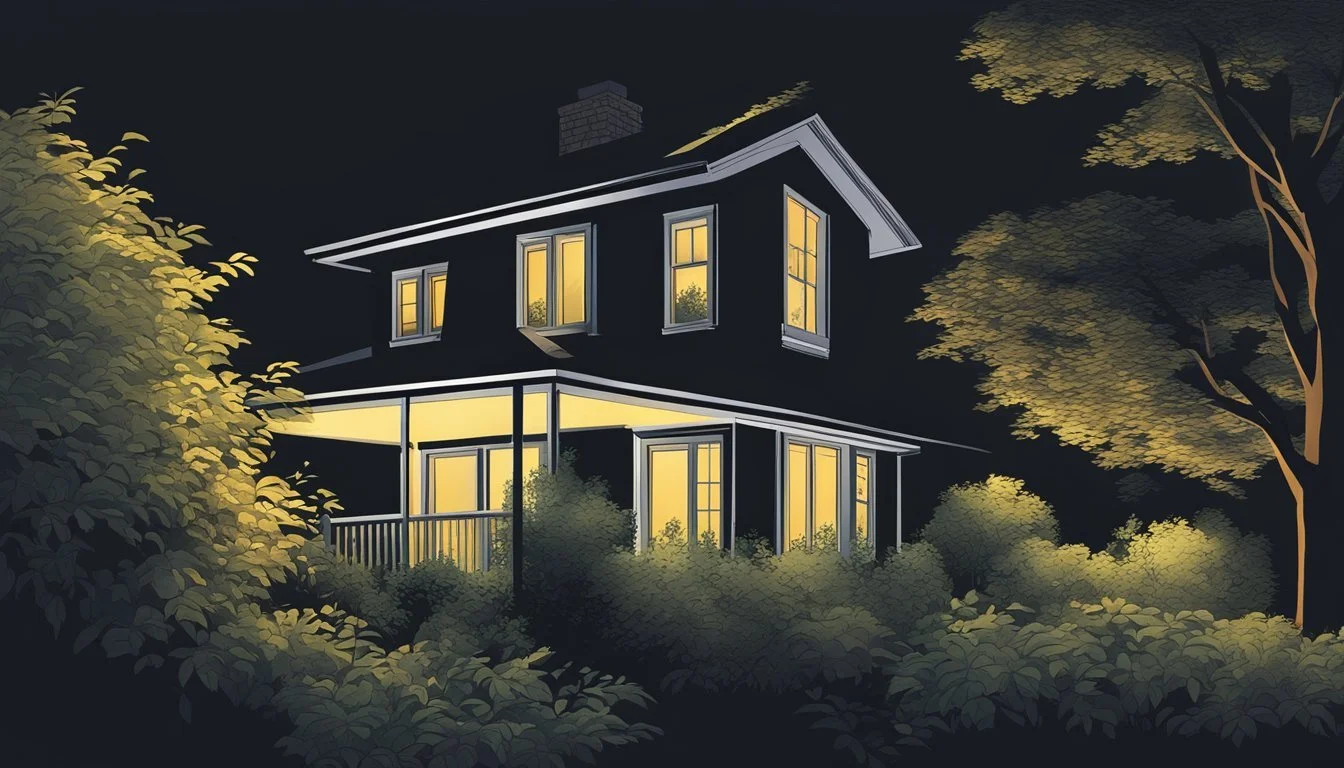Richard Ramirez: 10 Home Security Measures Inspired by the Night Stalker's Break-ins
Safeguarding Your Home Against Intruders
Richard Ramirez, infamously known as the Night Stalker, terrorized Los Angeles in the 1980s with a series of brutal home invasions, murders, and assaults. His crimes left a lasting impact on American society, particularly in terms of personal security and home protection.
The Night Stalker's break-ins exposed vulnerabilities in residential security, prompting homeowners to reevaluate and enhance their safety measures. This article examines 10 home security measures inspired by the tactics used during Ramirez's attacks, offering practical insights for modern homeowners to safeguard their properties and loved ones.
1) Install Sturdy Deadbolt Locks
Deadbolt locks are a crucial component of home security. They provide an extra layer of protection beyond standard doorknob locks. Installing deadbolts on exterior doors significantly enhances a home's defense against intruders.
To install a deadbolt, homeowners need to drill a hole in the door using a 2-1/8-inch hole saw. This creates space for the lock mechanism. A smaller 1-inch hole is then drilled into the door's edge for the bolt.
The strike plate, which receives the bolt, must be properly secured in the door frame. This involves drilling and chiseling a recess in the jamb. A well-installed strike plate ensures the deadbolt functions correctly.
High-quality deadbolts should be made of solid metal and have a bolt that extends at least one inch into the door frame. This design makes it much harder for intruders to force the door open.
For maximum security, deadbolts should be installed on all exterior doors, including those leading to garages or basements. Regular maintenance and testing of deadbolts help ensure they continue to provide effective protection.
2) Use Window Security Films
Window security films offer an effective deterrent against break-ins. These transparent, adhesive sheets are applied directly to glass surfaces, strengthening windows and making them more resistant to shattering.
When properly installed, security films can hold broken glass in place, preventing easy entry. This added layer of protection buys valuable time, potentially deterring intruders who rely on quick access.
Many security films also offer UV protection and energy efficiency benefits. Some higher-end options even include shatter-resistant properties that can withstand repeated impacts.
While not impenetrable, window films significantly increase the effort required to breach a window. This added difficulty can discourage potential intruders and prompt them to seek easier targets.
For optimal protection, consider combining security films with other window reinforcement methods. Professional installation ensures proper adhesion and maximum effectiveness of the film.
3) Motion-Activated Outdoor Lights
Motion-activated outdoor lights are an effective deterrent against intruders. These devices illuminate dark areas when they detect movement, startling potential burglars and alerting residents to activity outside their homes.
Modern motion sensor lights offer improved features compared to older models. Many now have adjustable sensitivity settings to reduce false alarms from small animals or passing cars.
LED technology has made these lights more energy-efficient and longer-lasting. Some models can provide up to 2000 lumens of brightness, effectively illuminating large areas.
Solar-powered options have gained popularity, eliminating the need for wiring and reducing electricity costs. These lights charge during the day and activate automatically at night when motion is detected.
Wi-Fi-enabled smart motion sensor lights allow homeowners to receive alerts on their phones when the lights are triggered. This feature provides real-time awareness of outdoor activity, even when residents are away from home.
Installing motion-activated lights near entry points, driveways, and dark corners of the property can significantly enhance home security. They serve as a visible deterrent and provide added safety for residents returning home after dark.
4) Secure Sliding Glass Doors
Sliding glass doors can be vulnerable entry points for intruders. Installing a secondary locking mechanism, such as a security bar or pin lock, adds an extra layer of protection. These devices prevent the door from being forced open, even if the primary lock is compromised.
Reinforcing the glass itself is crucial. Applying security film to the glass makes it more resistant to breaking. This transparent layer holds shattered glass together, making it difficult for an intruder to enter quickly and quietly.
Motion sensor lights near sliding doors deter potential burglars. When activated, these lights illuminate the area, exposing anyone attempting to access the door. Combining motion lights with visible security cameras creates a powerful deterrent.
Proper maintenance of sliding door tracks ensures smooth operation and prevents the door from being lifted out of its frame. Regular cleaning and lubrication of tracks and rollers is essential for optimal security and functionality.
Consider installing door sensors as part of a home security system. These alert homeowners when the door is opened, providing immediate notification of potential intrusions.
5) Install Security Cameras
Security cameras play a crucial role in home protection. They serve as both a deterrent and a means of capturing evidence in case of a break-in. When installing cameras, focus on covering entry points like doors and windows.
Position cameras at optimal angles to capture clear images of potential intruders. Consider placing them at eye level or slightly above for the best view of faces. Ensure cameras are visible from the outside to discourage would-be burglars.
Modern security cameras offer advanced features like night vision, motion detection, and remote viewing. These capabilities enhance their effectiveness in monitoring your property around the clock.
Wireless cameras provide flexibility in placement and can be easily moved if needed. However, wired systems may offer more reliable connections and are less susceptible to interference.
Remember to comply with local laws regarding camera placement, especially when it comes to neighboring properties. Regularly check and maintain your cameras to ensure they're functioning properly.
6) Reinforce Door Frames
Door frames are often overlooked weak points in home security. Richard Ramirez exploited this vulnerability during his break-ins. Strengthening door frames can significantly improve resistance against forced entry attempts.
Replace short screws in strike plates and hinges with longer ones, typically 3 inches or more. This anchors the frame components more securely to the studs behind the wall, increasing overall strength.
Install metal reinforcement plates on both the lock side and hinge side of the door frame. These distribute force from impact attempts across a wider area, making it harder for intruders to break through.
Consider adding a door reinforcement lock above the existing deadbolt. This provides an additional anchor point and further strengthens the frame against forceful entry methods.
For sliding doors, install security bars or pins in the tracks. This prevents would-be intruders from lifting the door off its track, a common entry technique used by burglars like Ramirez.
Regularly inspect door frames for signs of wear or damage. Replace rotting wood, tighten loose screws, and repair any cracks promptly to maintain optimal security.
7) Use Smart Doorbells
Smart doorbells provide an extra layer of security for homeowners. These devices allow you to see and communicate with visitors without opening the door.
Many smart doorbells feature motion sensors that alert you when someone approaches your property. This early warning system can be crucial in deterring potential intruders.
Video capabilities enable you to visually identify visitors, even when you're not at home. Some models offer night vision, ensuring clear footage in low-light conditions.
Two-way audio functionality allows you to speak with visitors remotely. This feature can be useful for screening unexpected guests or deterring suspicious individuals.
Smart doorbells often integrate with other home security systems. They can trigger alerts on your smartphone or activate connected security cameras for comprehensive monitoring.
Cloud storage options typically come with smart doorbells. This feature ensures that footage is saved even if the device is damaged or stolen.
By installing a smart doorbell, homeowners can enhance their property's security and gain peace of mind. These devices offer a modern solution to age-old security concerns.
8) Set Up Alarm Systems
Modern alarm systems offer robust protection against intruders like the Night Stalker. These devices can detect unauthorized entry and immediately alert homeowners and authorities.
Many systems include door and window sensors that trigger when breached. Motion detectors can identify movement inside the home when armed. Glass break detectors recognize the sound of shattering windows.
Smart alarms connect to mobile devices, allowing remote monitoring and control. They can send instant notifications if activated. Some systems incorporate cameras for visual verification of threats.
Professional monitoring services provide an extra layer of security. Trained staff can assess alarms and dispatch police if needed. This 24/7 protection gives peace of mind even when homeowners are away.
Installing visible alarm system signs and stickers can deter potential intruders. These warnings may cause criminals to seek easier targets. Regularly testing and maintaining the system ensures it functions properly when needed.
9) Trim Overgrown Shrubs
Overgrown shrubs can provide hiding spots for intruders, making them a potential security risk. Keeping shrubs neatly trimmed improves visibility around the home and eliminates potential concealment areas.
Regularly pruning shrubs, especially those near windows and doors, is an effective deterrent. It reduces shadows and dark spaces where someone could lurk unnoticed.
For optimal security, shrubs should be maintained at a height below window level. This prevents them from obscuring sightlines and allows for clear views of the property from inside the home.
When trimming, focus on thinning out dense growth to improve air circulation and light penetration. Remove up to one-third of the oldest, thickest stems at ground level.
For evergreen shrubs, prune in spring before new growth begins. Deciduous shrubs are best pruned immediately after flowering or in late winter while dormant.
Proper pruning techniques not only enhance security but also promote healthier plant growth. Well-maintained shrubs contribute to curb appeal while simultaneously bolstering home safety.
10) Use Timed Interior Lights
Timed interior lights can create the illusion of occupancy, deterring potential intruders. This technique involves setting up lights in various rooms to turn on and off at specific times throughout the evening and night.
Programmable smart bulbs or plug-in timers allow homeowners to create realistic lighting patterns. These can be set to mimic typical household activities, such as lights turning on in the living room in the early evening and bedroom lights activating later at night.
Randomized schedules add an extra layer of authenticity, making it difficult for observers to detect a predictable pattern. Some smart home systems even allow users to control lights remotely, providing flexibility and the ability to adjust lighting based on actual schedules.
Incorporating different types of lights, such as table lamps and overhead fixtures, can further enhance the impression of an occupied home. This variety simulates natural movement between rooms, potentially discouraging break-in attempts.
While timed lights alone cannot guarantee security, they serve as an effective component of a comprehensive home protection strategy. When combined with other measures, they significantly contribute to creating a less appealing target for potential intruders.
Understanding Richard Ramirez
Richard Ramirez, known as the Night Stalker, terrorized Los Angeles in the mid-1980s. His brutal crimes and methods of entry left a lasting impact on home security practices.
Profile of the Night Stalker
Richard Ramirez was born on February 29, 1960, in El Paso, Texas. He moved to California as a young adult and began his crime spree in 1984. Ramirez's victims ranged in age from 6 to 82.
He typically targeted homes at night, earning him the moniker "Night Stalker." Ramirez was known for his seemingly random victim selection and varied methods of attack.
His crimes included burglary, sexual assault, and murder. Ramirez often left Satanic symbols at crime scenes, adding to the public's fear.
Key Methods Used in Break-ins
Ramirez exploited common security weaknesses to gain entry into homes. He frequently targeted unlocked windows and doors, especially on ground floors.
Some of his preferred entry points included:
Sliding glass doors
Garage doors
Open windows
Ramirez often cut phone lines to prevent victims from calling for help. He also disabled exterior lights to maintain darkness and avoid detection.
The Night Stalker sometimes used tools like wire cutters and screwdrivers to bypass locks. In some cases, he simply walked through unlocked front doors.
These tactics highlighted the importance of basic home security measures like locking doors and windows, even in seemingly safe neighborhoods.
Modern Home Security Measures
Home security has evolved significantly since the Night Stalker's reign of terror. New technologies and strategies have emerged to protect homes and families from intruders.
Technological Advancements
Smart home security systems now offer comprehensive protection. These systems integrate door and window sensors, motion detectors, and cameras that can be monitored remotely via smartphone apps. Many include features like two-way audio communication and automatic alerts to authorities.
Biometric locks use fingerprints or facial recognition for entry, adding an extra layer of security. Video doorbells allow homeowners to see and speak with visitors without opening the door.
Some advanced systems incorporate artificial intelligence to distinguish between routine activities and potential threats. This reduces false alarms and improves response times to real emergencies.
Behavioral Strategies for Prevention
Proper lighting remains a crucial deterrent for burglars. Installing motion-activated lights around entry points and dark areas of the property can startle intruders and draw attention to suspicious activity.
Developing a neighborhood watch program fosters community vigilance. Regular communication between neighbors about unusual occurrences can help identify potential threats early.
Experts recommend varying daily routines to make homes less predictable targets. This includes changing the times you leave for work or return home, and alternating which lights are left on when away.
Securing valuables in a hidden safe and keeping important documents in a secure location adds another layer of protection against theft.
Historical Impact of Richard Ramirez
Richard Ramirez's crimes profoundly affected law enforcement practices and public perceptions of safety. His actions led to significant changes in security policies and altered how communities viewed their vulnerability to nighttime intrusions.
Changes in Security Policies
Ramirez's crime spree prompted widespread security upgrades in homes and businesses across California. Many residents invested in alarm systems, reinforced locks, and motion-sensing lights. Law enforcement agencies reassessed their response protocols for home invasions and serial crimes.
Police departments improved information sharing between jurisdictions to better track and apprehend serial offenders. The case highlighted the need for more comprehensive DNA databases and forensic techniques.
Courts began allowing greater use of DNA evidence in trials, partly due to its role in Ramirez's conviction. This shift accelerated the adoption of genetic evidence in criminal proceedings nationwide.
Influence on Public Perception
The Night Stalker case dramatically altered public awareness of home security vulnerabilities. Many people became more cautious about leaving windows open or doors unlocked, especially at night.
Media coverage of Ramirez's crimes sparked intense fear in communities throughout Southern California. This led to increased neighborhood watch programs and closer cooperation between residents and local police.
The case also raised awareness about the potential dangers posed by strangers and the importance of personal safety precautions. Schools and community organizations began offering more safety education programs in response to public demand.
Ramirez's crimes had a lasting impact on popular culture, inspiring numerous books, documentaries, and fictional portrayals that continue to shape perceptions of serial killers and home invasion crimes.










